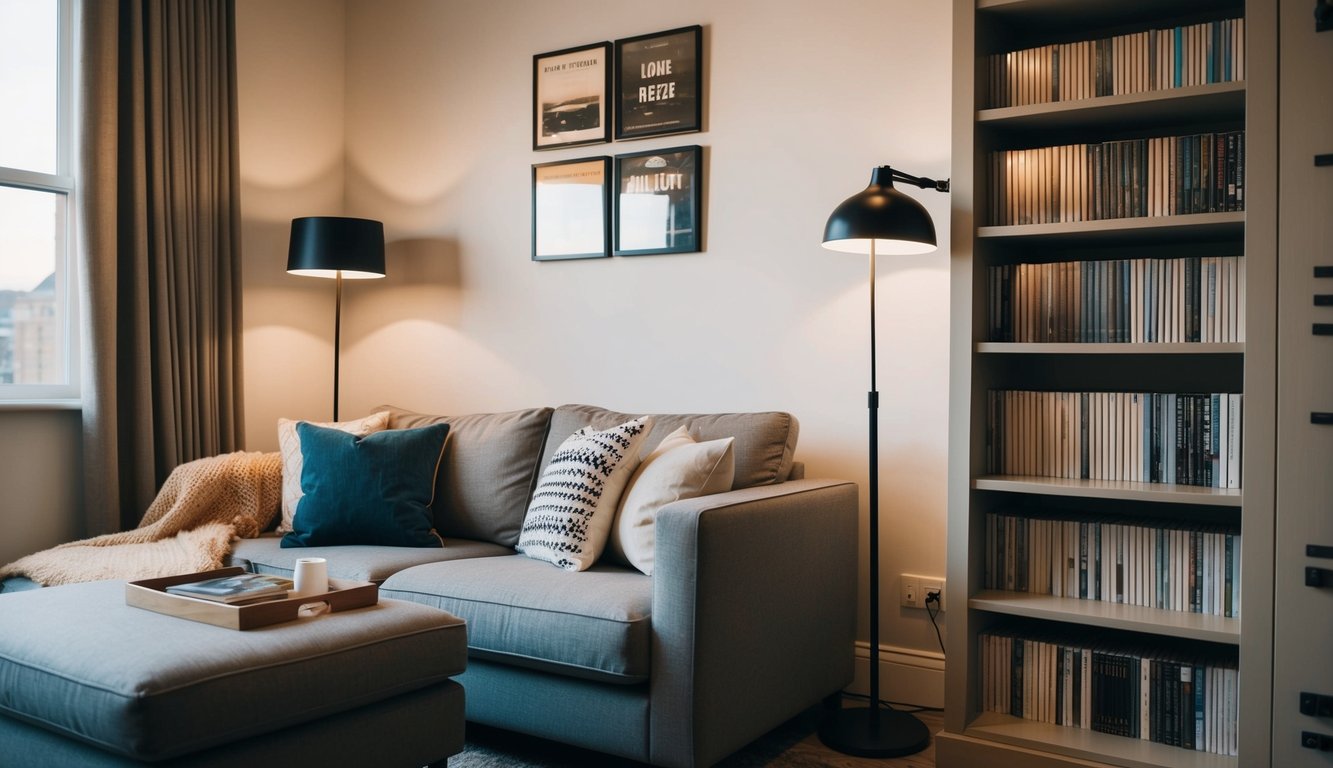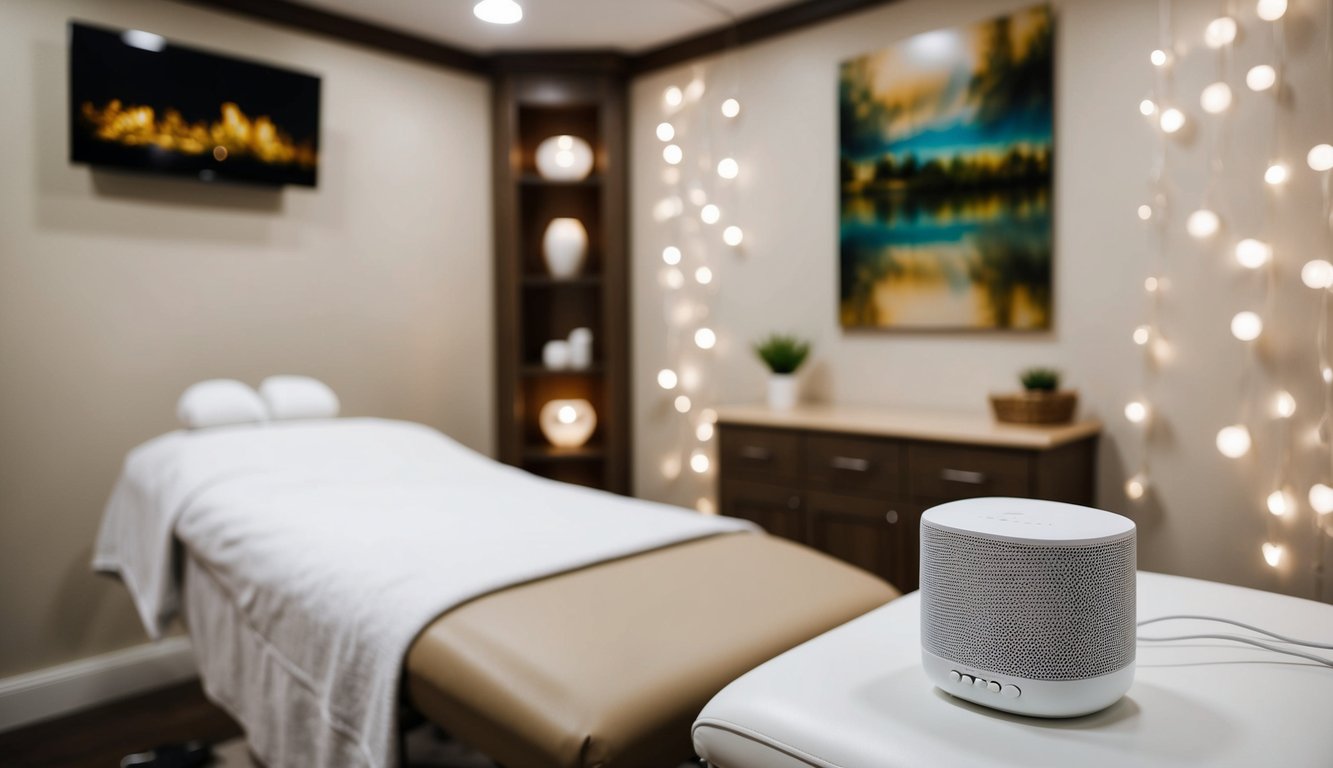Creating the perfect ambiance for your massage therapy sessions goes beyond just dim lighting and comfortable tables. Music and soundscapes play a crucial role in enhancing client comfort and relaxation.
Incorporating the best massage music into your sessions can transform the experience for both you and your clients, significantly improving client satisfaction.

When carefully selected, music and soundscapes can help reduce stress, lower blood pressure, and ease muscle tension.
Natural sounds and biophilic soundscapes are particularly effective in creating a soothing environment. They can promote feelings of comfort, safety, and calm while helping clients escape from everyday concerns.
To maximize the benefits of music and soundscapes in your massage therapy practice, consider factors such as genre selection, volume control, and the incorporation of natural light or warm-toned LED lights.
By crafting a holistic sensory experience, you can create an environment that truly supports healing and relaxation.
Key Takeaways
- Music and soundscapes significantly enhance client comfort and satisfaction during massage therapy sessions.
- Natural sounds and biophilic soundscapes are particularly effective in creating a soothing, stress-reducing environment.
- Carefully curated audio experiences, combined with appropriate lighting, can transform your space into a holistic healing environment.
The Importance of Music and Soundscapes in Holistic Healing Spaces

Music and soundscapes play a crucial role in creating a soothing environment for holistic healing. You’ll find that these audio elements can significantly enhance the overall experience in wellness centers, spas, and healthcare facilities.
Sound masking helps reshape healthcare environments to prioritize well-being. It creates a more peaceful atmosphere by reducing unwanted noise and promoting relaxation.
In holistic healing spaces, you may encounter:
- Gentle nature sounds
- Soft instrumental music
- Calming vocal harmonies
- Binaural beats
These auditory experiences can help you achieve a state of calm and receptiveness to healing practices.
Music therapy has become increasingly popular in various medical settings. From soothing premature infants to providing comfort during chemotherapy, the healing power of music is being recognized and utilized.
You might notice that different healing modalities incorporate specific sounds:
| Modality | Common Sounds |
|---|---|
| Meditation | Tibetan singing bowls |
| Yoga | Sanskrit chants |
| Reiki | Crystal bowls |
| Massage | Ocean waves |
Original music designed for wellness can be particularly effective. Certain frequencies are known to relax the mind and ease anxiety, making therapy sessions more impactful.
By carefully curating the audio environment, holistic healing spaces can create a more immersive and effective experience for you. This attention to sound helps foster a sense of calm, promoting better outcomes in your healing journey.
Understanding the Effects of Music on Relaxation and Stress Reduction
Music has a profound impact on our psychological and physiological states. It can alter mood, reduce stress, and promote relaxation through various mechanisms in the brain and body.
How Music Influences the Mind and Body
When you listen to music, your brain releases dopamine, a neurotransmitter associated with pleasure and reward. This chemical release can improve your mood and reduce feelings of anxiety.
Music also affects your heart rate and breathing, often slowing them down to induce a state of calm.
Different types of music can elicit various responses. Slow, classical music tends to lower blood pressure and heart rate, while upbeat tunes may energize you. Your personal preferences play a crucial role in how music affects you emotionally.
Music can serve as a powerful distraction from stressful thoughts or situations. By focusing on the melody, rhythm, or lyrics, you redirect your attention away from worries, allowing your mind to relax.
The Science Behind Music and Stress Relief
Studies have shown that music therapy and music interventions can significantly reduce stress-related outcomes. The effects are measurable through both psychological assessments and physiological markers like cortisol levels.
Music’s stress-reducing properties are linked to its ability to:
- Modulate the autonomic nervous system
- Influence the limbic system, which processes emotions
- Stimulate the release of endorphins, natural pain-relievers
Research indicates that listening to music before, during, or after stressful events can help mitigate the body’s stress response. This effect is particularly notable in medical settings, where music has been shown to reduce anxiety in patients undergoing surgery.
The long-term benefits of incorporating music into your stress management routine can be substantial. Regular use of music as a relaxation tool may lead to improved overall mental health and resilience to stress.
Selecting the Right Genres for Different Healing Modalities

Different music genres and soundscapes can profoundly impact client comfort and therapeutic outcomes. Choosing the appropriate audio environment enhances relaxation, focus, and overall well-being during healing sessions.
Classical Music for Calm and Focus
Classical music offers a structured and harmonious sound that can promote calmness and improve concentration. Its complex compositions engage the brain, potentially reducing anxiety and stress.
When selecting classical pieces for your healing space, consider slower tempos and gentle melodies.
Mozart’s piano concertos or Bach’s orchestral suites can create a soothing atmosphere. These works often feature predictable patterns that may help clients feel more at ease. For a more contemporary classical experience, try minimalist composers like Philip Glass or Ludovico Einaudi.
Remember to keep the volume at a comfortable level. Too loud, and it might become distracting; too soft, and clients may strain to hear it.
Nature Sounds for a Grounding Experience
Nature sounds can transport clients to serene outdoor settings, fostering a sense of peace and connection to the natural world. These sounds can be particularly effective for grounding exercises and stress relief.
Consider incorporating:
- Gentle rainfall
- Ocean waves
- Forest ambience with bird calls
- Babbling brooks or waterfalls
You can use high-quality recordings or sound machines to recreate these environments. Combine different nature sounds to create a custom soundscape tailored to your clients’ preferences.
Ambient and Instrumental Music for Deep Relaxation
Ambient and instrumental music provide a non-intrusive backdrop that can facilitate deep relaxation and introspection. These genres often lack lyrics, allowing clients to focus inward without the distraction of words.
Some effective choices include:
- Slow tempo piano solos
- Soft guitar instrumentals
- Synthesizer-based ambient tracks
- Meditative singing bowl recordings
Artists like Brian Eno, Sigur Rós, or Nils Frahm offer excellent options in this category. Experiment with different styles to find what resonates best with your clients.
Pay attention to tempo, as slower rhythms (around 60 beats per minute) can help synchronize breathing and heart rates, promoting relaxation.
Creating Custom Playlists for Client Comfort

Custom playlists can significantly enhance client comfort during therapy sessions. By tailoring music selections to individual preferences and needs, therapists can create a soothing environment that promotes relaxation and openness.
Assessing Client Preferences and Needs
To create effective playlists, start by gathering information about your client’s musical tastes and emotional needs. Ask about favorite genres, artists, and songs.
Consider using questionnaires or informal conversations to uncover music-related memories or associations.
Pay attention to your client’s emotional state and therapeutic goals. Music can impact mood and emotional resilience, so choose tracks that align with desired outcomes.
For relaxation, select slower tempos and calming melodies. For motivation, opt for upbeat rhythms and inspiring lyrics.
Keep in mind that preferences may change over time. Regularly check in with your client to ensure the playlist remains relevant and beneficial.
Balancing Variety and Consistency in Playlists
When building playlists, strike a balance between familiarity and novelty. Include a mix of your client’s favorite tracks and new selections that match their preferences. This approach provides comfort while encouraging exploration.
Create a cohesive flow by arranging tracks to maintain a consistent emotional tone. Avoid abrupt changes that might disrupt the therapeutic atmosphere.
Consider grouping songs by mood, tempo, or genre to create smooth transitions.
Experiment with playlist length and structure. Some clients may benefit from shorter, focused playlists, while others might prefer longer, more diverse selections. Adjust based on session duration and client feedback.
Tools and Resources for Building Playlists
Utilize digital platforms to streamline playlist creation and management. Popular streaming services like Spotify, Apple Music, and YouTube Music offer extensive libraries and playlist-building features. These tools allow you to easily add, remove, and reorder tracks.
Consider using mood playlist generators to discover new songs that match your client’s preferences. Many streaming platforms offer personalized recommendations based on listening history.
Explore specialized apps designed for therapeutic music applications. These tools often include features like tempo adjustment, loop creation, and mood tracking to enhance the playlist-building process.
Collaborate with your clients by sharing playlist links or using collaborative playlist features. This approach empowers clients to contribute to their therapeutic experience and reinforces the therapeutic alliance.
Incorporating Ambient Noise in Treatment Rooms

Ambient noise can significantly enhance client comfort and relaxation during treatments. Carefully selected soundscapes create a soothing atmosphere, reduce stress, and promote healing.
The Role of White Noise and Natural Soundscapes
White noise and natural soundscapes play a crucial role in treatment rooms.
White noise masks disruptive sounds, providing a consistent auditory background. It helps clients focus and relax by reducing distractions.
Natural soundscapes, like ocean waves or forest ambiance, can transport clients to calming environments. These sounds reduce stress and promote healing.
You can choose soundscapes that match your treatment theme or client preferences.
Consider alternating between white noise and natural sounds based on the treatment phase. Use white noise during more intense procedures and switch to natural soundscapes during recovery periods.
Techniques for Seamlessly Integrating Ambient Noise
To seamlessly integrate ambient noise, start with low volume levels and gradually increase as needed. This allows clients to adjust without feeling overwhelmed.
Use sound diffusion techniques to create an immersive experience. Place speakers strategically around the room for even distribution.
Consider ceiling-mounted or wall-mounted options to save space.
Synchronize ambient noise with other sensory elements:
- Lighting: Dim lights with calming sounds
- Aromatherapy: Match scents to soundscapes (e.g., pine scent with forest sounds)
- Temperature: Adjust room temperature to complement the audio environment
Allow clients to control volume or choose from a selection of pre-set ambient noise options. This personalization enhances their comfort and engagement with the treatment.
Equipment and Technology for Optimal Sound Quality
Invest in high-quality audio equipment to ensure clear, crisp sound reproduction. Choose speakers with wide frequency ranges to accurately represent both low and high tones in natural soundscapes.
Consider using adaptive music stations that respond to client movement or biorhythms. These interactive systems can create a more personalized and engaging experience.
Implement a centralized audio control system for easy management across multiple treatment rooms. This allows you to adjust settings quickly and maintain consistency.
Use noise-cancelling technology to minimize external disruptions. This creates a more immersive environment and enhances the effectiveness of your chosen ambient sounds.
Regularly maintain and update your audio equipment to ensure optimal performance. Schedule periodic sound quality checks to identify and address any issues promptly.
Practical Tips for Implementing Music and Soundscapes

Implementing music and soundscapes effectively requires careful planning and execution. The right setup and adjustments can significantly enhance client comfort and overall experience.
Setting Up Your Sound System
Choose high-quality speakers or headphones for optimal sound delivery. Position speakers strategically to create an immersive environment without overwhelming the space.
Consider using wireless systems for flexibility and clean aesthetics.
Invest in a reliable audio player or streaming device. Ensure it has a user-friendly interface for easy navigation and playlist management.
Create playlists in advance to maintain a seamless flow of music or soundscapes throughout the client’s visit.
Test your system regularly to prevent technical issues during sessions. Keep backup equipment on hand, such as portable speakers or a secondary audio player, to minimize disruptions.
Adjusting Volume and Sound Levels
Start with a lower volume and gradually increase it to find the sweet spot. Pay attention to the room’s acoustics and adjust accordingly.
Use a decibel meter app to maintain consistent and appropriate sound levels.
Balance different audio elements if you’re combining music with environmental sounds. Ensure that neither overpowers the other, creating a harmonious blend.
Consider using a volume limiter to prevent sudden loud noises that might startle clients. This is especially important when using streaming services that may have varying volume levels between tracks.
Monitoring and Adjusting Based on Client Feedback
Pay close attention to your clients’ reactions to the music or soundscapes. Look for signs of relaxation or discomfort in their body language and facial expressions.
Ask for feedback directly, but do so in a way that doesn’t disrupt their experience. Simple questions like “Is the music comfortable for you?” can provide valuable insights.
Be prepared to make quick adjustments based on client preferences. Keep alternative playlists or soundscapes ready for different tastes or moods.
Remember that personal preferences vary, so flexibility is key.
Document client preferences in their records for future visits. This attention to detail can significantly enhance their comfort and show that you value their individual needs.
Conclusion

Music and soundscapes play a crucial role in creating a comfortable and relaxing atmosphere for clients in massage centers and spas. By carefully selecting the right audio elements, you can significantly enhance the overall experience.
Soothing music and soundscapes help craft an audible aura that complements the physical environment. This combination can transport clients to a state of tranquility, allowing them to fully unwind during their treatments.
Consider implementing biophilic soundscapes to create a positive distraction and evoke a sense of being in nature. These natural sounds can aid in attention restoration and provide valuable moments for rest and reflection.
Offer variety in your audio selections to cater to different preferences. You might include options for gentle instrumental music, nature sounds, or ambient tracks. This flexibility allows you to personalize the experience for each client.
By thoughtfully incorporating music and soundscapes into your spa or massage center, you create a multisensory environment that promotes relaxation and enhances the therapeutic benefits of your services.
Frequently Asked Questions

Music profoundly influences mood, emotions, and behavior. It can be used for therapeutic purposes and personal well-being when applied thoughtfully. Understanding music’s effects helps optimize its use for enhancing comfort and emotional development.
What is the impact of music on mood and emotions?
Music directly affects the brain’s emotional centers. Upbeat tunes can boost your mood and energy, while slower melodies may induce relaxation. Lyrics can evoke specific feelings or memories.
Your emotional state can shift rapidly in response to music. This makes it a powerful tool for mood regulation and emotional processing.
How can music therapy settings be optimized for client comfort?
Choose calming instrumental tracks or nature sounds to create a soothing atmosphere. Soft, gentle rhythms work well for massage and relaxation therapies.
Personalize playlists based on client preferences. Adjust volume to a comfortable background level. Consider using high-quality speakers for optimal sound distribution.
In what ways does music influence human behavior?
Music can alter your physical responses. Upbeat music may increase your heart rate and motivate movement, while slower tempos tend to reduce stress and lower blood pressure.
It can also impact your focus and productivity. Classical music often enhances concentration, while familiar lyrics might be distracting during tasks requiring mental effort.
Can music have negative effects on one’s mood?
Certain songs may trigger unpleasant memories or emotions. Loud or aggressive music can increase stress and anxiety in some individuals.
Overreliance on music for mood regulation can potentially hinder the development of other coping mechanisms. Balance is key in using music as an emotional tool.
How can music contribute to emotional development?
Exposure to varied musical styles broadens your emotional vocabulary. It helps you recognize and process complex feelings.
Engaging with music through singing or playing instruments can boost self-expression and emotional intelligence. It provides a safe outlet for exploring and releasing emotions.
What are effective methods to use music for mood improvement?
Create playlists tailored to different moods or activities.
Use uplifting music to start your day or motivate yourself during exercise.
Practice mindful listening.
Focus on the various elements of a song to ground yourself in the present moment.
This can help shift your attention away from negative thoughts.






